Mental Toughness
![]()

|
|
The Carlstedt
Protocol goes well beyond the speculative and hypothetical that marks most
forms of mental training today by providing objective assessments and
documentation of basic
This mental performance enhancement Protocol is not some simplistic quick-fix type of mental training, rather it is a reliable and validated method for inducing positive change, having implications not only for sport and performance, but for one’s quality of life. The Carlstedt Protocol requires time and practice initially, but once it has been internalized you will benefit the rest of your life and career, as an athlete and a person.
The Elusive "Zone"
In theory, mental training is usually designed to bring you closer to the “Zone” or “Ideal state. However, without knowing the psychophysiological parameters of YOUR “Ideal” state, the “Zone” will always be elusive, a hit or miss “feeling” most athletes have probably experienced, but are hard pressed to replicate let alone manipulate.
The ZONE can be documented and more readily accessed using a special assessment, monitoring, and biofeedback protocol I have developed centering on heart activity. Before discussing this protocol let's first learn more about heart activity and its relationship to psychological performance.
Heart Activity: Your Window to the Subconscious and the Zone
Heart
activity and more specifically heart rate deceleration (HRD) is a
psychophysiological measure that best illuminates the mind-body
interaction and the ZONE.
Heart rate deceleration is not the same as heart rate slowing, a phenomenon that occurs in all players once action ceases. It is erroneous to equate mere heart rate slowing with increased mental performance. Heart rate slowing is a metabolic occurrence. By contrast heart rate deceleration is a psychophysiological or mind-body phenomenon that can be viewed as a window to the subconscious, as well as a validated measure of intensity, attention/inattention, cognitive processing (thinking) and even the imagery process.
Heart rate deceleration reflects increased attention or concentration on an important stimulus like the service motion and ball when returning serve. It is an "orienting response" that induces a specific heart and brain interaction or feedback loop in which the heart regulates the blood pressure and flow to the certain areas of the brain to facilitate heightened attention and reduce "cognitive flooding" or "perceptual overload," that is, distracting stimuli and thoughts. Heart rate deceleration indicates a player is fully aware or focused, while shutting out superfluous images, stimuli, and thoughts, and is also associated with faster reaction times and better performance.
|
When you see Andre Agassi effortlessly smack his returns for winners even when facing the biggest of serves you are observing the effects of fine-tuned subconscious heart-brain interactions, including heart rate deceleration, that have evolved over years of training. His neuro-cardiac pathways have been programmed to respond optimally. This does not mean you don’t have a chance to develop such a brain-heart response system without years of practice, in fact you already have such a response system built in, you already have the hard-wiring, it just has to be adapted to tennis.
Decades of research has clearly established that heart rate deceleration reflects is a species-wide (that means everyone) subconscious response to an important or meaningful stimulus. For example, a sudden noise in the dark of night might cause you to focus on its origin - a response accompanied by heart rate deceleration much in the same way as Agassi exhibits it when focusing on a return of serve. The trick now is to manipulate heart activity when playing tennis so as to play at your highest level – the Zone.
How Heart Rate Deceleration Kicks In
Once a point is over the heart slows anyway, rarely would it increase. So again, don't confuse general heart slowing with anything other than a metabolic response to less energy demands. However, as a player prepares for the next point, say, when returning serve, while in the ready position, if focused, they will exhibit a series of heart beats that are longer or slower than preceding beats (HRD). They get progressively slower or longer until action commences, for example, when the opponent's racquet accelerates to hit the serve. Visually it looks like graphic below.
Imagine
the following lines are heartbeats. ( I_____I = heart cycle/one heart
beat).
|
|
|
Between points,
the heart rate is relatively constant and regular:
I__I__I_I___I__I__I......................... |
However,
once a player focuses, HRD kicks in.
|
Once the action commences, the heart beats become shorter or faster.
A
player who is nervous and not focused or caught up in negative or
extraneous thoughts would not exhibit the above pattern, instead you might
see a heart rate pattern like this: I_I___I__I__I__I_I_I_I_I__I_I
A Study of Heart Rate Deceleration in a Tennis Player
To test whether the above Heart Rate Deceleration patterns would be evident during tennis and also associated with better match performance and outcome I used ambulatory heart monitoring equipment to measure a player's heart activity over the course of two entire official tournament matches. I predicted that greater heart rate deceleration would occur in a match won than in one that was lost.
The
results of my study showed HRD differences that looked like this:
Match
1, Won 6-4, 6-2
I__I_____I__________I_________________I____________________I
Match
2, Lost 6-0, 6-1
I_I___I_____I________I___________I
Notice
the differences in length of 5 heart beat cycles between the two matches.
Although HRD was exhibited in both matches, successive heartbeats leading
up to action in Match 1 were longer or slower than Match 3, indicating
more HRD in the winning compared to the losing match.
My
study showed greater heart rate deceleration was associated with
significantly better performance. It clearly distinguished a match that
was won from one that was lost. The heart rate deceleration exhibited in
this study was consistent with previous research, and showed for the first
time in an action sport that heart rate deceleration was associated with a
meaningful outcome measure during a real tennis tournament match, namely
winning or losing a match.
Documenting heart rate variability parameters appears to be the only means currently available to make an athlete’s psychological performance more transparent (visible). Heart activity is also the most reliable measure for validating the effects of mental training. Validating what mental training methods are supposed to do is crucial for learning how to manipulate psychophysiological states and entering the ZONE.
Manipulating
Heart Activity to Improve Performance?
Although
usually subconsciously mediated, heart rate deceleration can be
consciously manipulated; so the motto is: MIND YOUR HEART...and you may
indeed be able to get into the ZONE when you desire.
Obviously, doing so is easier said than done. Nevertheless there are Sport Psychologists and practitioners including myself who have conducted research on heart rate deceleration, who are capable of MINDING YOUR HEART, that is, they can assess, monitor and help you manipulate brain-heart or mind-body interactions to enhance performance. Doing this is a significant leap forward, a jump well beyond most of what is occurring in most of Sport Psychology today where simplistic and unscientific approaches are pervasive.
|
Even
if you have learned various mental training techniques such as imagery,
progressive relaxation, self-talk, and various “psyching” methods, you
still need to know how or if they are affecting you psychophysiologically.
What influence if any do they have on actual tennis performance? This
brings us to the Carlstedt Protocol a mental training procedure for
learning how to manipulate brain-heart interactions among other factors to
increase attention, reduce reaction times, and improve psychological
performance.
I’d like to stress that just knowing mental training methods does not suffice or guarantee they will be effective. I therefore encourage any player to experience this protocol, especially its psychophysiological assessment and biofeedback components. If you invest in your game by taking tennis lessons and perhaps have even seen a Sport Psychologist or attended mental training seminars, go the extra yard and finally discover how your mind-body connection functions. Once you’ve experienced a few sessions you’ll be astounded by the information you derive and the confidence you will gain in knowing how to manipulate your mental game and how to access the elusive ZONE. It is an investment that any player wanting to improve should consider and something all coaches should integrate into their repertoire.
The Carlstedt
Protocol
Let's
say a player has difficulty focusing during critical moments in a match.
To deal with this problem they might seek out a sport psychologist or
other type of practitioner. They might learn mental imagery or other
techniques to help overcome their problem. But that's usually the extent
of it. Usually it's a hit-or-miss proposition, and more often a miss in
that rarely does the practitioner or player really know what an effect the
mental training will have.
To really determine the effect of mental training interventions one needs to monitor and assess objective psychophysiological measures and associate them with meaningful outcome measures such as whether a match is won, or one performs better, say whenever break-points occur.
-
The first step in assessing the efficacy of mental training is diagnostic and descriptive and involves taking a battery of tests to determine ability to use imagery, monitor subconscious processes, etc. These tests help predict how an athlete will respond psychophysiologically to stress in competitive situations.
-
Next, a psychophysiological stress test is administered in an office or lab. The results reflect a persons reactivity to stress. The results of this test are compared to the initial assessment tests. If they are strongly related one can forgo the lab stress test in future sessions.
|
-
Thereafter the tennis player is placed in a competitive situation wearing heart-monitoring equipment. Heart rate deceleration trends are then studied relative to important moments in competition. This analysis offers reliable insight into a players overall psychological state during competition.
-
Finally the player is ready to enter the mental training phase. Using biofeedback and other techniques we can train players to control heart rate activity. In biofeedback we teach players mental strategies that help them manipulate or induce heart rate deceleration.
The
idea behind biofeedback is to monitor psychophysiological activity and
have a player observe their actual responses on a screen. During the
biofeedback process stimuli are introduced to help a player observe and
feel the psychophysiological responses they emit (e.g., what sort of heart
response occurs when a person awaits a serve). During this process players
are taught mental strategies for manipulating psychophysiological
responses in the direction most conducive to peak performance, for example
learning heart rate deceleration. Eventually a player is capable of
consistently inducing the desired response.
The first portion of the biofeedback process always involves seeing the screen for feedback. Later a player is weaned from the screen. After having learned biofeedback they are usually capable of regulating their psychophysiological responses on the court. They are capable of recognizing mental states that are outside the ZONE and shifting back to states associated with the ZONE including those used to induce heart rate deceleration
|
Biofeedback requires practice just like working on strokes. Biofeedback refresher sessions should be used whenever necessary, for example, when a player goes into a slump or plays a very poor match. Devices are available for very basic biofeedback check-ups and practice a player can use once an understanding of the principles behind this method of mental training is acquired.
Although
learning biofeedback and heart rate deceleration will not guarantee
victory, it will provide assurance that matches are not being lost due to
mental factors.
In a subsequent VIDEO article I will detail on court work with competitive players using these heart monitoring and biofeedback techniques?
Your comments are welcome. Let us know what you think about this article by emailing us
here at TennisONE.
How, Where, and When Can I Learn Heart Activity Biofeedback?Players or coaches who want more information regarding these techniques or the training to learn them can visit www.americanboardofsportpsychology.org. Currently I am presenting my training protocol on an international basis for tennis clubs, teams, coaches, educators, schools, and businesses.
If
you are interested in a Carlstedt Protocol Performance Enhancement
Presentation, Seminar, or Testing Session please contact: DrRCarlstedt@aol.com
or call 917-680-3994
Dr. Carlstedt's dissertation on neuropsychological processes in highly skilled athletes (700) from 7 sports including tennis is being nominated for the Society of Neuroscience's Annual 2002 Lindsley Award for Best Dissertation in Behavioral Neuroscience. This article is based on Dr. Carlstedt's Master's Thesis: Carlstedt, R.A.(1998). Psychologically mediated heart rate variability: A single case study of heart rate deceleration and a spectrum analysis of autonomic function during tournamment tennis. Masters Thesis, San Francisco: Saybrook Graduate School, and an article for Biofeedback Magazine a peer reviewed journal. Dr. Carlstedt's thesis can be purchased for $20.00 plus postage, contact: DrRCarlstedt@aol.com. |
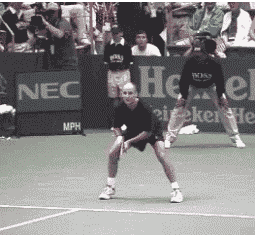
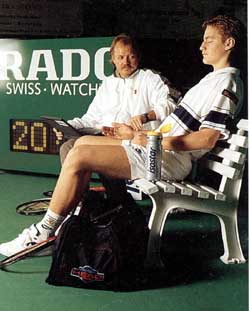
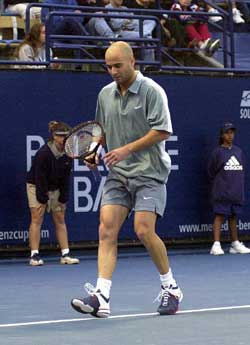

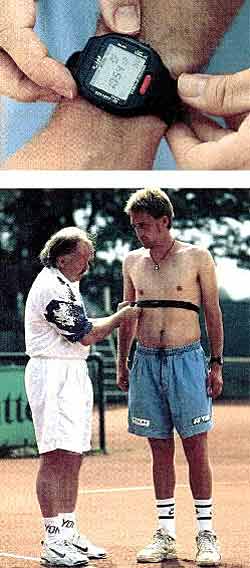
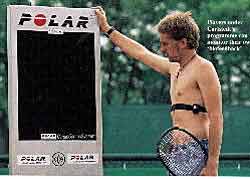

 TennisONE
is pleased to welcome Dr. Roland A. Carlstedt to our family of
contributors. Roland, a Board Certified Sport Psychologist and
Tennis Coach earned his Doctorate (Ph.D.) in Psychology from
Saybrook Graduate School in San Francisco under the renowned
Personality Psychologist and Behavioral Geneticist Dr. Auke Tellegen
of the University of Minnesota.
TennisONE
is pleased to welcome Dr. Roland A. Carlstedt to our family of
contributors. Roland, a Board Certified Sport Psychologist and
Tennis Coach earned his Doctorate (Ph.D.) in Psychology from
Saybrook Graduate School in San Francisco under the renowned
Personality Psychologist and Behavioral Geneticist Dr. Auke Tellegen
of the University of Minnesota.